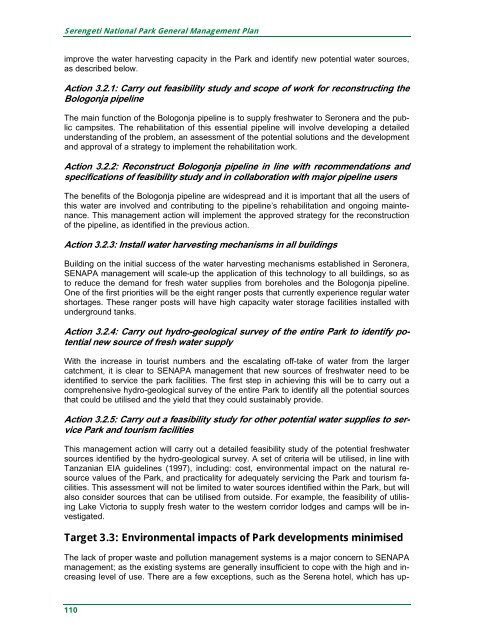Serengeti General Management Plan
Serengeti General Management Plan
Serengeti General Management Plan
- TAGS
- serengeti
- www.zgf.de
Create successful ePaper yourself
Turn your PDF publications into a flip-book with our unique Google optimized e-Paper software.
<strong>Serengeti</strong> National Park <strong>General</strong> <strong>Management</strong> <strong>Plan</strong><br />
improve the water harvesting capacity in the Park and identify new potential water sources,<br />
as described below.<br />
Action 3.2.1: Carry out feasibility study and scope of work for reconstructing the<br />
Bologonja pipeline<br />
The main function of the Bologonja pipeline is to supply freshwater to Seronera and the public<br />
campsites. The rehabilitation of this essential pipeline will involve developing a detailed<br />
understanding of the problem, an assessment of the potential solutions and the development<br />
and approval of a strategy to implement the rehabilitation work.<br />
Action 3.2.2: Reconstruct Bologonja pipeline in line with recommendations and<br />
specifications of feasibility study and in collaboration with major pipeline users<br />
The benefits of the Bologonja pipeline are widespread and it is important that all the users of<br />
this water are involved and contributing to the pipeline’s rehabilitation and ongoing maintenance.<br />
This management action will implement the approved strategy for the reconstruction<br />
of the pipeline, as identified in the previous action.<br />
Action 3.2.3: Install water harvesting mechanisms in all buildings<br />
Building on the initial success of the water harvesting mechanisms established in Seronera,<br />
SENAPA management will scale-up the application of this technology to all buildings, so as<br />
to reduce the demand for fresh water supplies from boreholes and the Bologonja pipeline.<br />
One of the first priorities will be the eight ranger posts that currently experience regular water<br />
shortages. These ranger posts will have high capacity water storage facilities installed with<br />
underground tanks.<br />
Action 3.2.4: Carry out hydro-geological survey of the entire Park to identify potential<br />
new source of fresh water supply<br />
With the increase in tourist numbers and the escalating off-take of water from the larger<br />
catchment, it is clear to SENAPA management that new sources of freshwater need to be<br />
identified to service the park facilities. The first step in achieving this will be to carry out a<br />
comprehensive hydro-geological survey of the entire Park to identify all the potential sources<br />
that could be utilised and the yield that they could sustainably provide.<br />
Action 3.2.5: Carry out a feasibility study for other potential water supplies to service<br />
Park and tourism facilities<br />
This management action will carry out a detailed feasibility study of the potential freshwater<br />
sources identified by the hydro-geological survey. A set of criteria will be utilised, in line with<br />
Tanzanian EIA guidelines (1997), including: cost, environmental impact on the natural resource<br />
values of the Park, and practicality for adequately servicing the Park and tourism facilities.<br />
This assessment will not be limited to water sources identified within the Park, but will<br />
also consider sources that can be utilised from outside. For example, the feasibility of utilising<br />
Lake Victoria to supply fresh water to the western corridor lodges and camps will be investigated.<br />
Target 3.3: Environmental impacts of Park developments minimised<br />
The lack of proper waste and pollution management systems is a major concern to SENAPA<br />
management; as the existing systems are generally insufficient to cope with the high and increasing<br />
level of use. There are a few exceptions, such as the Serena hotel, which has up-<br />
110
















